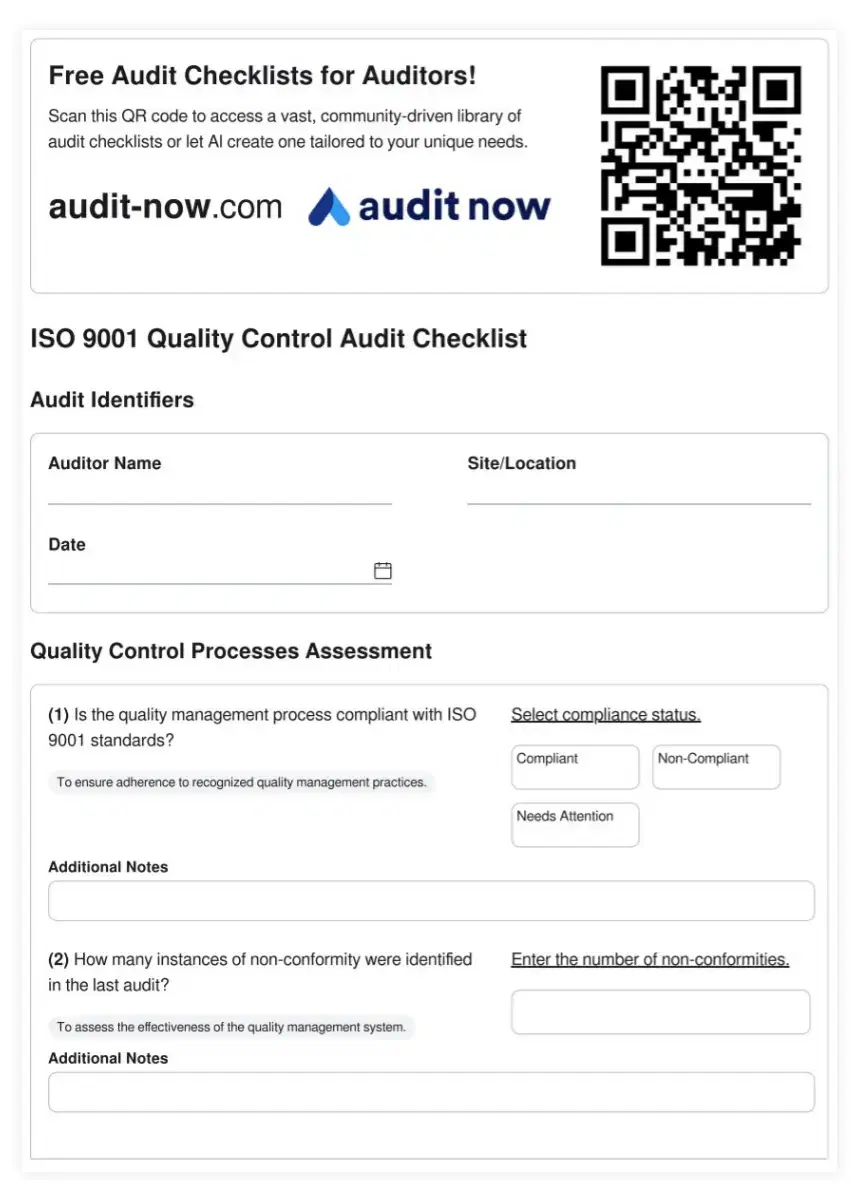Warehousing is no longer just about storage—it’s the engine that keeps supply chains running smoothly. In today’s fast-paced business environment, efficient warehouse operations are essential for meeting customer demands and driving growth.
28 Sep 2025
•
Beril Işık

Featured Checklist

Warehouse Robotics and Autonomous Systems Audit Checklist
The integration of robotics and autonomous systems in warehouses is transforming the logistics and transportation industry, offering unprecedented levels of efficiency and accuracy. This comprehensive audit checklist is designed to evaluate and optimize the implementation, performance, and maintenance of robotic and autonomous systems within warehouse operations. By assessing key areas such as robotic picking systems, autonomous guided vehicles (AGVs), drone technology, human-robot collaboration, safety protocols, and system integration, this checklist helps logistics professionals maximize the benefits of automation while ensuring smooth operations and worker safety. Regular audits using this checklist can lead to significant improvements in operational efficiency, order fulfillment speed, and overall warehouse performance in the rapidly evolving landscape of automated logistics.
Warehouses have always been more than storage spaces. In today’s global supply chains, they act as the heartbeat of operations. They are the places where the staff receives and checks the products. Then they stores the products and ship them with precision.
Once, this was a back-end function. It has become a critical driver of customer satisfaction and business growth. The efficiency of warehouse operations determines the destiny of businesses. Because the supply chains grow more complex and customer expectations rise with time.
Successful warehouse operations rely on the seamless coordination of different moving parts. Each step must function as part of a larger system. The steps include inventory control and order fulfillment. The steps designed for accuracy, speed, and reliability.
Keeping track of stock is the foundation of smooth warehouse operations. Proper inventory control ensures the right products are in the right place at the right time. This helps teams make faster, smarter decisions every day.
The right inventory control process includes the following steps:
Ensure accuracy, reduce errors, and keep operations running smoothly with Audit Now
Start Now
Efficient order fulfillment is key to meeting customer expectations and keeping operations running. Warehouses can reduce errors by streamlining the picking, packing, and shipping process. They can ensure orders reach customers on schedule.
The following practices can help to ensure staff process every order in a :
Maintaining safety and compliance is critical for smooth warehouse operations. This protects both employees and inventory. It also ensures that the process meets regulatory standards.
To achieve these goals, warehouses should focus on key practices. The practices should reinforce safety and ensure compliance. They include:
By aligning these elements, warehouses can create a foundation of consistency and accountability. This must scale with business growth.
Technology is no longer optional in modern warehouse operations. It’s the backbone of efficiency. Digital tools enhance visibility and reduce costly human errors. Besides, they also improves the speed.
Technology helps warehouse managers to make informed decisions in real time. This happens in a wide range: from automated inventory tracking to AI-powered analytics,
At the end, this step maintains accuracy across different locations. This ensures that operations remain agile and responsive to changing demand.
Using warehouse management systems (WMS) and digital checklists helps streamline workflows, optimize labor.
A Warehouse Management System (WMS) is a central tool for a warehouse. It helps warehouses run efficient. It tracks inventory in real time, manages workflows, and optimizes storage space.
A WMS provides better visibility and control. It ensures that goods move from receiving to shipping without any mistake. It also reduces errors and improves productivity. The advantages of technology for WMS include:
Automation and robotics are transforming modern warehouse operations. They speed up repetitive tasks and reduce human error. These technologies increase efficiency, improve accuracy in a wide range. This includes automated picking systems and robotic pallet movers
At the end, they allow staff to focus on higher-value activities. Integrating automation ensures faster order processing and more consistent operational performance.
Data and analytics play a crucial role in optimizing warehouse operations. Managers gain valuable insights into warehouse operations if they track key metrics. Analyzing performance allows them to make informed decisions. This step will improve efficiency, reduce costs, and prevent errors.
Leveraging data ensures operations are proactive rather than reactive, driving continuous improvement. To put data insights into action, warehouses can focus on practical applications. The applications will improve efficiency and accuracy, such as:
Audit Now support these operations. It offers customizable checklists and automated compliance tracking. This ensures warehouses don’t work faster, but also smarter. The warehouses use reliable systems that adapt to different industry needs.
Even with the best technology, people remain central to warehouse success. Trained, motivated staff working within well-defined processes are key to keeping operations running.
A well-trained workforce is the backbone of successful warehouse operations. Continuous training ensures employees can adapt to new technologies. They can also follow safety standards, and carry out tasks with accuracy.
Development programs build technical skills. Moreover, they improve problem-solving and teamwork. At the end, they have more resilient and capable teams.
Warehouses should focus on structured training initiatives to have a strong team. We can list the initiatives as such:
Process optimization is one of the most important drivers of warehouse efficiency. Well-designed workflows cut down wasted time, reduce errors, and improve order accuracy.
By fine-tuning processes, warehouses can handle higher volumes and meet customer expectations faster. Finally, they can lower operating costs.
To put process optimization into practice, warehouses can focus on a few key areas. They will improve consistency, efficiency, and communication:
Modern warehouse operations are complex ecosystems that integrate people, processes, and technology. If they focus on accurate inventory management, businesses can strengthen their operations. With the smart use of technology, they can also make those operations more resilient. The operations will meet both regulatory standards and customer expectations too. The future of warehouse operations lies in balance. The balance is where efficiency, compliance, and innovation work together to deliver real value.
Audit Best Practices: Learn More
What Does a Restaurant Manager Do? Key Responsibilities and Best Practices
The Complete Guide to Restaurant Inventory Management in 2025